Last updated on November 27th, 2023
Oklahoma is the 28th most populous and the 20th most extensive of the 50 states of the United States. It lies in the South Central region of the United States. The state attained statehood on November 16, 1907, becoming the 46th state to join the union. It shares its border with six states (Missouri, New Mexico, Texas, Arkansas, Colorado, and Kansas.) See the full list of the 50 states and their borders here. Oklahoma (nicknamed: the Sooner State) has 77 counties. The state’s capital is Oklahoma City. People who live in Oklahoma or who come from Oklahoma are called Oklahomans or Oklahomians. The abbreviation for Oklahoma is OK. With these facts about Oklahoma, let us learn about its history, geography, people, culture, economy and more.
Interesting facts about Oklahoma
1. The name of the state is derived from the choctaw words “okla” and “humma”, meaning “red people”.
2. The Oklahoma state motto is “Labor Omnia Vincit” – Labor conquers all things.
3. Oklahoma was added to the United States as a part of the Louisiana Purchase of 1803.
4. Oklahoma City is the second-largest capital city in the United States by area.
5. Another amazing fact about OK is that that after California, Oklahoma has the second largest Native American population in the country.
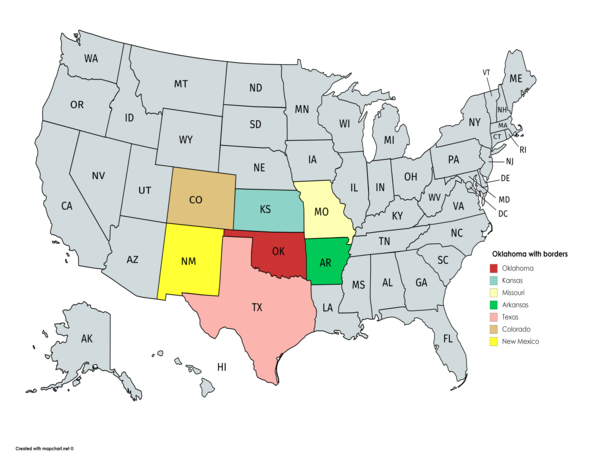
6. Oklahoma is home to 39 tribes.
7. Since explorers first visited the territory that became Oklahoma, as many as 14 flags have flown over it including those of four foreign nations.
8. In 1889, when the U.S. government had planned to open approximately 2 million acres of land for settlement, many people entered the land before the land’s run designated time. These people were dubbed “sooners.” In 1907, Oklahoma became the 46th American state. The next year the University of Oklahoma’s football team took “Sooners” as its nickname. The expression “sooners” was then embraced as a nickname for the entire state. It is interesting to note here that on April 22, a pistol shot started the land run.
9. Did you know that the land runs brought homesteaders from Japan, China, England, Mexico, Canada and France to Oklahoma? Thus the state has a population originating from a wide range of geographies and ethnicities.
Oklahoma on the map
10. Cimarron County in OK is the only county in the United States that borders counties in five different states that include – Kansas, Colorado, Texas, New Mexico, and Oklahoma. And it is also the only county in the nation that borders four states including– Kansas, Colorado, New Mexico, and Texas.
11. The Red River is 1,290 miles (2,080 km) long; for about half this distance, it serves as the Texas-Oklahoma boundary. The River’s color comes from the clay and minerals in the water.
12. With more than 200, Oklahoma has the largest number of man-made lakes of any state in the United States. Isn’t this an impressive OK state fact?
13. The Oklahoma Panhandle consists of three counties – Cimarron (the state’s least populous county), Texas and Beaver, from west to east. The name of the regions comes from its similarity to the shape of a handle of a cooking pan. The region is 166 miles long and just 34 miles wide.
14. The state’s highest point is Black Mesa and the lowest point is Little River.
15. Dinosaur fossils have been found at two places in Oklahoma. These fossils were found in the Black Mesa area in the Panhandle and near Atoka.
16. Because of the droughts and high winds that the state suffered during the 1930s, more than a million residents of Oklahoma migrated to California. The migrants were known as “Okies”.
17. The “Dust Bowl” was the name given to the Southern Plains region of the United States that suffered from severe dust storms during a dry period in the 1930s. Due to the high winds and chocking dust, people and livestock were killed and crops failed across the entire region. The effects of the Dust Bowl coupled with the Great Depression pushed people to look elsewhere for work and better living conditions. The Dust Bowl, also known as “the Dirty Thirties,” started in 1930 and lasted for about a decade.
18. The worst dust storm during the period occurred on a Sunday on April 14, 1935, when 3 million tons of top soils are estimated to have blown off the Great Plains. The dust would move inside of even the well-sealed homes leaving a coating on food, skin and furniture.

19. Tornadoes are common in the state. Between 1950 and 2022, Oklahoma has been hit by 4184 tornadoes. Thus, on average, the state was hit by at least 57.3 tornadoes each year. For more data about tornadoes in the region, explore this source.
20. Did you know that on March 25, 1948, the US’s first tornado forecast was made in Oklahoma, which changed the weather world? The forecast by two Air Force Officers and a meteorologist helped save many lives.
21. Due to the fact that the state is hit with tornadoes frequently, the state is also considered as a part of “Tornado Alley.” Tornado Alley is a nickname given to an area in the southern plains of the central United States that consistently experiences a high frequency of tornadoes each year.
22. In 2007, the longest lightning flash spanned a distance of 321 km (199.5 miles) horizontally from Tulsa near the Arkansas/Oklahoma border to the Oklahoma Panhandle above the United States.
23. Did you know that Oklahoma’s state capitol building is the only capitol building with an oil well directly underneath it?
24. Another interesting fact about Oklahoma is that it is the only state in the U.S. that produces Iodine. It is also one of the only four states that produce Helium.
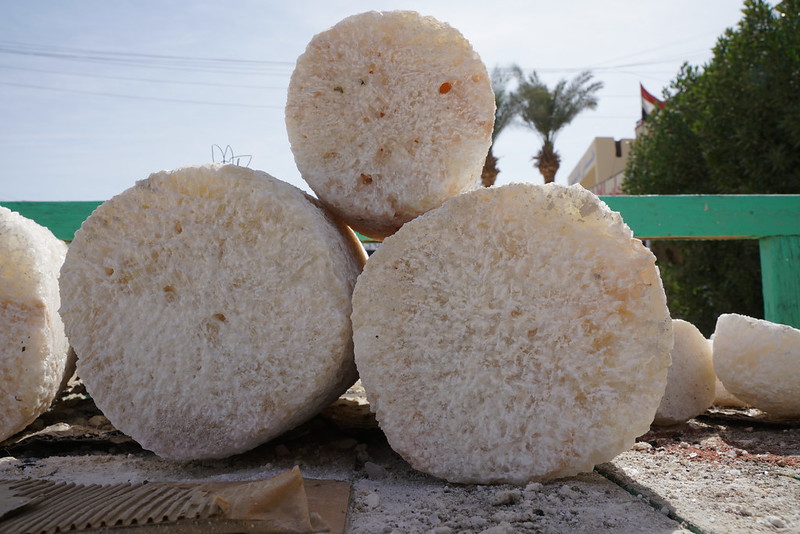
25. The Alabaster Caverns near Freedom, Oklahoma, have the largest alabaster deposits in the world. Deposits of rare black alabaster and pink gypsum are present here.
26. Pitcher, Oklahoma is one of the most toxic towns in the United States. The town was once a booming mining community and since the end of the mining activity in 1967, the town is left with dangerous levels of zinc, cadmium and lead. Furthermore, the data from EPA suggests that another town – Kotzebue in Alaska has the dubious honor of being the most toxic town in the U.S. The “Red Dog Mine” in the town is considered the source of release of toxic chemicals into the environment.
27. Did you know that an oil well in OK erupted for 11 days before being brought under control? The incident happened in 1930 when the Mary Sudik No. 1 well erupted after striking a high-pressure formation of about 6,500 feet beneath the state capital. This well produced an astonishing 20,000 barrels of oil and 200 million cubic feet of natural gas a day.
28. Shopping carts were first invented and used in Oklahoma before they were used anywhere else in the world. Sylvan Goldman, the owner of the Humpty Dumpty supermarket chain in Oklahoma City, came up with an idea to build shopping carts to assist his customers in shopping. The first prototype of the cart was based on the folding chair. And on June 4, 1937, the cart was launched. Initially, it was a flop, however, with some advertising, the inventor managed to influence the shoppers to use the carts.
29. The United States Army post, Fort Stilt, near Lawton, Oklahoma, is where combat aviation was first invented. It all started in 1915 when the 1st Aero Squadron was created.
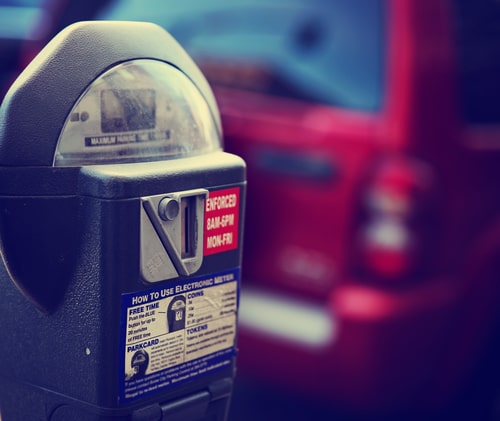
30. The world’s first parking meter, known as Park-O-Meter No. 1, was installed in the business district of Oklahoma City, Oklahoma, on 16 July 1935.
31. Edwin Malzahn was born in Perry, Oklahoma; he was the man who invented the Ditch Witch in 1949. The trencher replaced the shovel to install underground utilities.
32. Field’s World’s Best Pecan Pie was first sold in 1925 in Pauls Valley, Oklahoma. The Field brothers opened a small restaurant and persuaded their wives to cook it for their customers.
33. The first Girl Scout cookie sold in the US was in Muskogee, Oklahoma, in 1917. The Mistletoe Troop baked cookies and sold them at the school cafeteria.
34. Arcadia, Oklahoma has the world’s largest sculpture pop bottle. Neon lights are used to light up the 66-foot-tall sculpture at night.
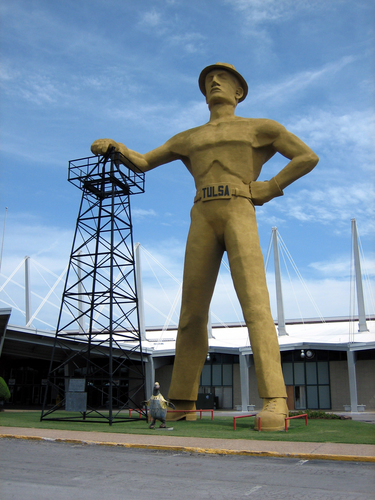
35. “Golden Driller” in Tulsa, Oklahoma is the sixth tallest statue in the United States. The statue was erected in 1953 to honor the workers of the oil industry. It is 75 foot tall and weighs 19,700 kg. For the most part of the 20th century, Tulsa, Oklahoma was known as the “Oil Capital of the World”.
36. The Pioneer Woman, a heroic bronze statue of a young woman, is seventeen feet high and weighs 12,000 pounds. It was erected in 1930. Pioneer Woman Museum was dedicated September 15, 1958, just east of the statue. The statue and the Museum depict and preserve the legacy of women from all races who have contributed to the development of Oklahoma.
37. There are half-hexagon elevators in the Price Tower in Bartlesville, Oklahoma. The tower was designed by the famous American architect Frank Lloyd Wright. This remarkable office block of concrete and copper was constructed for Harold C. Price as his business head office.
38. Did you know that no Democratic presidential candidate has won a single county in the state since 2000?
39. An interesting historical fact is that the bread twist tie was invented in Mayville, Oklahoma, in 1961. Charles Burford is the person who invented it.
40. The Oklahoma City, the capital of the state, is near the centre of the state.
The state flag of Oklahoma
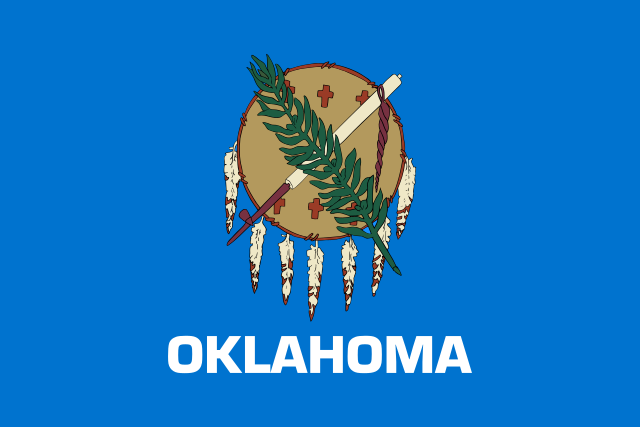
About the flag of Oklahoma
1. The Oklahoma flag is honorary of over 60 Native Americans and their ancestors’ groups. The flag’s blue field is extracted from a flag carried by the Choctaw soldiers during the American civil wars. Its center shield represents the battle shield of the Osage warriors.
2. The flag is decorated with eagle feathers and is made of buffalo leather, and its two peace symbols lie across the shield. The first symbol is the calumet, also referred to as the peace pipe, and the second symbol is an olive branch. The flag’s shield crosses represent Native American star signs symbolizing high ideals.
3. The flag was adopted on 2nd April 1925 and was designed by Louise Funk Fluke based on Joseph Thoburn of the Oklahoma Historical Society.
4. Blue is the primary color of the Oklahoma flag, making up its background in entirety. The Choctaw carried during the civil wars inspired the flag’s main color. The blue color is as well a symbol of devotion.
5. The flag is a unique representation of state traditions and heritage. It features a traditional Osage nation buffalo-skin shield in the center with seven eagle feathers attached to the bottom. The flag has six crosses on the seal representing the Native American symbols stars — the shield as well as eagle feathers spaced at its bottom.
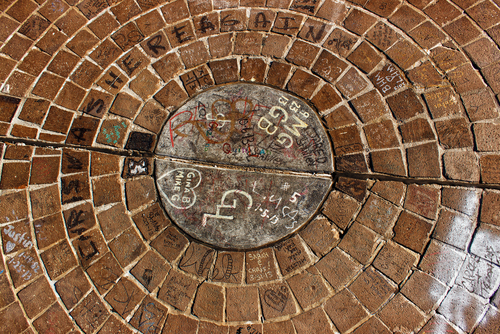
41. The Center of the Universe, as it is commonly known in Oklahoma, is situated in downtown Tulsa. You might not understand the fuss about it by looking at it. The secret lies in how the fantastic spot defies the physics laws. Interestingly, you get to hear an intensified echo after you make a sound when inside the circle, but people outside the circle do not hear anything.
42. Oklahoma is the fifth most obese state in the U.S.
43. Interestingly, the famous lawman and gunman Tom Threepersons was born in Vinita, Oklahoma, in 1889. His family moved to Canada in the 1900s, where he became a lawman.
44. Did you know that Brad Pitt, a famous American actor, is a native of Oklahoma? William Bradley Pitt was born in Shawnee, Oklahoma.
45. Did you know that Lottie Williams from Tulsa, Oklahoma is the only person who has ever been hit with space trash? On January 22, 1997, she was hit by a 6-inch-long piece of a rocket. She did not sustain any injuries as the rocket hit her shoulder. Note that your odds of actually getting hit are about one in a trillion.
46. According to NASA’s fact book, Oklahoma is the state that produced the most astronauts. Five of the total astronauts were born in Oklahoma.
47. According to a study, Oklahoma is the fifth worst state to have a baby. Mississippi (worst) tops the list followed by Alabama (second worst).
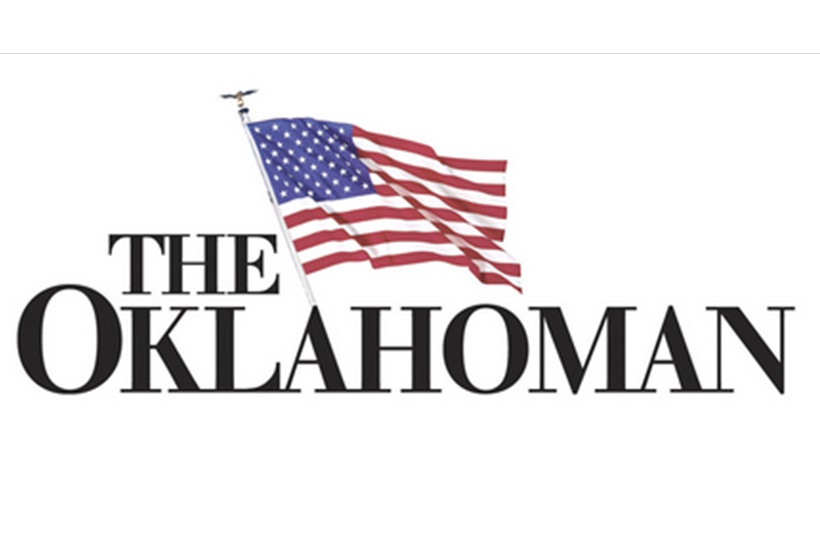
48. “The Oklahoman” is the largest newspaper in the state and the 54th largest in the nation by circulation.
49. Oklahoma’s economy is supported by livestock products such as cattle, dairy and broilers. The state receives majority of farm receipts from these sources. The state also produces plenty of wheat as well as others crops including peanuts, cotton, hay, sorghum etc.
50. Did you know it was illegal to have a tattoo in Oklahoma up to 2006? The practice was banned in the state since 1963.
51. Mackenzie Wethington, a teenage girl in Chikasa, Oklahoma, survived a 3,500-foot fall in 2014. It happened when the parachute failed to open.
. . . continue reading facts about Oklahoma on the next page
